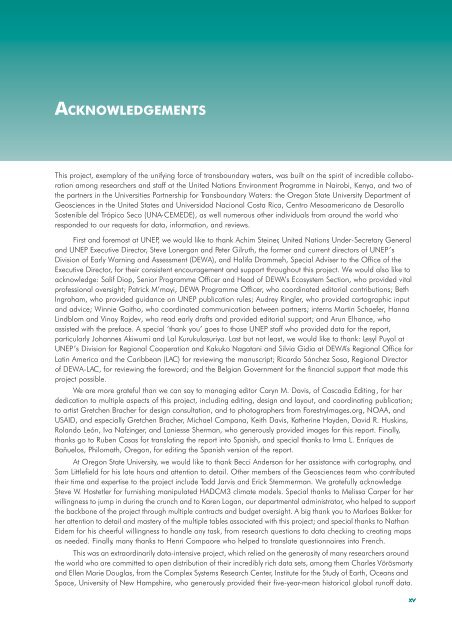Latin America; in English (pdf) - Transboundary Freshwater Dispute ...
Latin America; in English (pdf) - Transboundary Freshwater Dispute ...
Latin America; in English (pdf) - Transboundary Freshwater Dispute ...
Create successful ePaper yourself
Turn your PDF publications into a flip-book with our unique Google optimized e-Paper software.
ACKNOWLEDGEMENTS<br />
This project, exemplary of the unify<strong>in</strong>g force of transboundary waters, was built on the spirit of <strong>in</strong>credible collaboration<br />
among researchers and staff at the United Nations Environment Programme <strong>in</strong> Nairobi, Kenya, and two of<br />
the partners <strong>in</strong> the Universities Partnership for <strong>Transboundary</strong> Waters: the Oregon State University Department of<br />
Geosciences <strong>in</strong> the United States and Universidad Nacional Costa Rica, Centro Mesoamericano de Desarollo<br />
Sostenible del Trópico Seco (UNA-CEMEDE), as well numerous other <strong>in</strong>dividuals from around the world who<br />
responded to our requests for data, <strong>in</strong>formation, and reviews.<br />
First and foremost at UNEP, we would like to thank Achim Ste<strong>in</strong>er, United Nations Under-Secretary General<br />
and UNEP Executive Director, Steve Lonergan and Peter Gilruth, the former and current directors of UNEP’s<br />
Division of Early Warn<strong>in</strong>g and Assessment (DEWA), and Halifa Drammeh, Special Adviser to the Office of the<br />
Executive Director, for their consistent encouragement and support throughout this project. We would also like to<br />
acknowledge: Salif Diop, Senior Programme Officer and Head of DEWA’s Ecosystem Section, who provided vital<br />
professional oversight; Patrick M’mayi, DEWA Programme Officer, who coord<strong>in</strong>ated editorial contributions; Beth<br />
Ingraham, who provided guidance on UNEP publication rules; Audrey R<strong>in</strong>gler, who provided cartographic <strong>in</strong>put<br />
and advice; W<strong>in</strong>nie Gaitho, who coord<strong>in</strong>ated communication between partners; <strong>in</strong>terns Mart<strong>in</strong> Schaefer, Hanna<br />
L<strong>in</strong>dblom and V<strong>in</strong>ay Rajdev, who read early drafts and provided editorial support; and Arun Elhance, who<br />
assisted with the preface. A special ‘thank you’ goes to those UNEP staff who provided data for the report,<br />
particularly Johannes Akiwumi and Lal Kurukulasuriya. Last but not least, we would like to thank: Lesyl Puyol at<br />
UNEP’s Division for Regional Cooperation and Kakuko Nagatani and Silvia Gidia at DEWA’s Regional Office for<br />
<strong>Lat<strong>in</strong></strong> <strong>America</strong> and the Caribbean (LAC) for review<strong>in</strong>g the manuscript; Ricardo Sánchez Sosa, Regional Director<br />
of DEWA-LAC, for review<strong>in</strong>g the foreword; and the Belgian Government for the f<strong>in</strong>ancial support that made this<br />
project possible.<br />
We are more grateful than we can say to manag<strong>in</strong>g editor Caryn M. Davis, of Cascadia Edit<strong>in</strong>g, for her<br />
dedication to multiple aspects of this project, <strong>in</strong>clud<strong>in</strong>g edit<strong>in</strong>g, design and layout, and coord<strong>in</strong>at<strong>in</strong>g publication;<br />
to artist Gretchen Bracher for design consultation, and to photographers from ForestryImages.org, NOAA, and<br />
USAID, and especially Gretchen Bracher, Michael Campana, Keith Davis, Kather<strong>in</strong>e Hayden, David R. Husk<strong>in</strong>s,<br />
Rolando León, Iva Nafz<strong>in</strong>ger, and Laniesse Sherman, who generously provided images for this report. F<strong>in</strong>ally,<br />
PREFACE ???<br />
thanks go to Ruben Casas for translat<strong>in</strong>g the report <strong>in</strong>to Spanish, and special thanks to Irma L. Enríques de<br />
Bañuelos, Philomath, Oregon, for edit<strong>in</strong>g the Spanish version of the report.<br />
At Oregon State University, we would like to thank Becci Anderson for her assistance with cartography, and<br />
Sam Littlefield for his late hours and attention to detail. Other members of the Geosciences team who contributed<br />
their time and expertise to the project <strong>in</strong>clude Todd Jarvis and Erick Stemmerman. We gratefully acknowledge<br />
Steve W. Hostetler for furnish<strong>in</strong>g manipulated HADCM3 climate models. Special thanks to Melissa Carper for her<br />
will<strong>in</strong>gness to jump <strong>in</strong> dur<strong>in</strong>g the crunch and to Karen Logan, our departmental adm<strong>in</strong>istrator, who helped to support<br />
the backbone of the project through multiple contracts and budget oversight. A big thank you to Marloes Bakker for<br />
her attention to detail and mastery of the multiple tables associated with this project; and special thanks to Nathan<br />
Eidem for his cheerful will<strong>in</strong>gness to handle any task, from research questions to data check<strong>in</strong>g to creat<strong>in</strong>g maps<br />
as needed. F<strong>in</strong>ally, many thanks to Henri Compaore who helped to translate questionnaires <strong>in</strong>to French.<br />
This was an extraord<strong>in</strong>arily data-<strong>in</strong>tensive project, which relied on the generosity of many researchers around<br />
the world who are committed to open distribution of their <strong>in</strong>credibly rich data sets, among them Charles Vörösmarty<br />
and Ellen Marie Douglas, from the Complex Systems Research Center, Institute for the Study of Earth, Oceans and<br />
Space, University of New Hampshire, who generously provided their five-year-mean historical global runoff data.<br />
xv
















